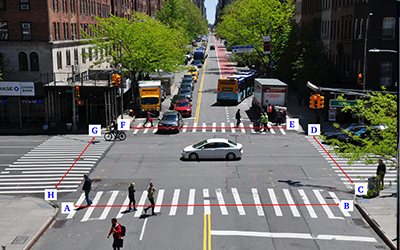Traffic Data Analysis

Traffic Data Analysis

Turning Movement Counts
Traffic turning movement counts are a type of traffic survey that involves counting automobiles, bicycles, and pedestrians using specific roads, paths, or crossroads. The primary goal is to optimize the flow of vehicles passing through an intersection during peak times. Our study includes counting left turns, right turns, U-turns, and through movements for each approach. This process, commonly referred to as Counting the Turning Movements, provides essential data for traffic management and planning, enabling us to identify patterns and make informed decisions to enhance intersection efficiency.

Link and Midblock Counts
Understanding traffic volume and vehicle class composition on any roadway is essen-tial for strategic planning, improvements, and maintenance. This information helps determine key metrics such as Average Daily Traffic (ADT) and Peak Hour Traffic (PHT). We employ video technology to survey and analyze roadway volume and vehicle classification, providing accurate and up-to-date data, including the Federal Highway Administration (FHWA) 13-category vehicle classification. This enables better deci-sion-making for optimizing traffic flow, enhancing safety, and planning future infra-structure developments.
Roundabout / Multi-Camera Tracking
Our experienced team specializes in conducting traffic counts for various junction layouts, from medium to complex multi-camera roundabouts and large gyratories, accommodating any number of vehicle classifications. We excel in 100% vehicle tracking on large roundabouts, ensuring precise and comprehensive data collection. Using state-of-the-art technology, we monitor traffic flow and turning movements in real time, enabling accurate analysis of traffic patterns. Our customized reports highlight peak traffic hours, vehicle types, and movements, empowering clients to make informed decisions on traffic management and infrastructure planning. Our team is adept at addressing various challenges, such as poor visibility, high traffic volumes, and complex road networks. With a commitment to accuracy and reliability, we provide unparalleled support for all traffic survey needs.

Origin-Destination Counts (ANPR, Videos)
We validate the number plates captured by our ANPR software, manually inputting any plates missed by the system to ensure a complete raw data set. This data is then matched between sites, allowing us to provide a final Origin-Destination Matrix tailored to the client’s requirements. For video analysis, we manually extract number plates from footage to compile the raw data set, subsequently delivering the Origin-Destination Matrix as specified. Our analysis can be customized for various scenarios, including examining travel patterns between cities, assessing routes through key intersections, or evaluating traffic within campus areas, parks, or shopping malls. Clients can choose to analyze data for any day of the week and at any hour, providing a comprehensive view of transportation dynamics that supports informed planning and decision-making.

Queue Length Analysis Services
we provide comprehensive Queue Length Analysis Services tailored to meet the specific needs of our clients. Our services encompass a range of metrics,including the longest and shortest queues, average queue lengths, and queues at the start of green phases. We also conduct detailed queue delay surveys and utilize multiple cameras to monitor queue dynamics from one end of the highway to the other. Our advanced Queue Length Analysis solutions employ cutting-edge data analytics and real-time tracking technology to deliver precise insights into queue lengths, wait times, and customer flow patterns. This data-driven approach enables businesses to make informed decisions, streamline operations, reduce customer wait times, and enhance overall efficiency. By understanding the correlation between queue length and customer satisfaction, we help organizations improve their service quality and retain customers. Queue length analysis is a powerful tool for transforming waiting experiences into opportunities for operational excellence. Through accurate measurement, real-time analysis, and insights from successful case studies, we empower businesses to optimize their queue management and deliver exceptional service. Our goal is to turn waiting times into a positive aspect of the customer journey, ensuring a seamless and satisfying experience for all.

Pedestrian Data Analysis
we specialize in pedestrian data analysis to enhance operations across diverse settings. We ensure the accuracy of technology in shopping centers by comparing real-time data with automated systems, guaranteeing optimal performance and reliability. Our expertise also covers outdoor events, where we analyze visitor behavior to improve event planning and crowd management. We assess pedestrian and vehicle movements at intersections to optimize traffic light phasing and crossing placements, enhancing safety and efficiency. Our demographic studies provide detailed insights into pedestrian age and gender, aiding targeted strategic planning and marketing efforts. We conduct advanced audits of people counting systems to verify data precision in shopping malls and retail environments. Our comprehensive traffic video recording services monitor pedestrian and bicycle movements at intersections for 5, 15, or 60-minute intervals, essential for refining traffic signal design and flow. Our pedestrian crossing analysis delivers consistent accuracy in both indoor and outdoor settings, supporting effective data-driven decision-making. With real-time updates, robust two-level authentication, and algorithmic verification, we ensure data accuracy and privacy. By leveraging our data for benchmark comparisons, you can evaluate and enhance your performance against industry standards, confidently advancing your strategic goals.

Parking Survey: On-Road and Off-Road Parking Counts
On-road parking involves vehicles being parked directly on the street or sidewalk, often with varying restrictions or permit requirements, and is generally quick and cost-effective to implement. In contrast, off-road parking, such as in dedicated parking lots or garages, entails higher costs and longer construction times due to the need for property acquisition, paving, and facility development. On-road parking typically caters to short-term needs with minimal physical infrastructure, while off-road parking supports both short-term and long-term usage, requiring extensive operational facilities like toll systems and comprehensive physical improvements. This distinction is crucial for urban planning and traffic management, influencing both the design and functionality of parking solutions.

Level Crossing Monitoring & Reporting
We specialize in monitoring railway level crossings, focusing on barrier downtime and uptime, train arrival times and directions, pedestrian crossings, and vehicle movements. Our comprehensive analysis also addresses traffic turning near the crossing, blocking back traffic, and any unusual behaviors, such as improper parking, maintenance activities,vehicles circumventing barriers, and pedestrians crossing while barriers are down. This thorough monitoring provides valuable insights that enhance safety and operational efficiency at level crossings.

Traffic Gap Survey
In non-signalized intersections, such as "T" or four-arm intersections and roundabouts, the major stream typically has priority. Vehicles from the minor stream must slow down or stop to find a suitable gap in the major stream. Our survey measures these gaps to determine allowable wait times and assess intersection service levels. We evaluate how vehicle delays are influenced by gaps in both streams—small gaps in the major stream lead to longer delays for the minor stream, while small gaps in the minor stream can cause longer queues. This analysis provides valuable insights into when an intersection might require signal control to enhance service levels.

Illegal Movement Counts Analysis
we utilize video camera footage to monitor and report illegal traffic movements on specific roads over extended periods. This long-term observation allows us to determine the volume and frequency of such violations. Furthermore, these illegal movements can be integrated into our Traffic Turning Counts, providing a comprehensive analysis of road behavior and contributing to a deeper understanding of traffic patterns and safety issues.

Bus Occupancy Survey
Using video footage, we monitor bus arrival and departure times, as well as boarding and alighting counts categorized by gender and age. We also track bus service numbers and vehicle classifications, including different types of buses and their capacities. Additionally, we provide detailed insights tailored to client requirements, offering a comprehensive view of bus station operations and passenger demographics. This data supports effective planning and management of bus services and station facilities.

Taxi Rank Monitoring
Efficient taxi rank management is crucial for optimizing airport operations and enhancing passenger experience. Relying solely on manual counts or flight schedules to gauge taxi and ride-sharing demand often leads to overcrowding and dissatisfaction. Poorly managed queues can negatively impact passenger perception of airport services and increase reliance on private transport, straining terminal infrastructure. Our Passenger Flow Management System (PFMS) offers a robust solution for monitoring and improving taxi rank operations. By integrating real-time and historical data from both indoor and outdoor sources, PFMS helps operators manage passenger flow effectively. Key performance indicators (KPIs) generated by the system inform staff about critical aspects such as passenger flow rates, queuing space management, and line development for taxi and ride-sharing services. With PFMS, airports can enhance throughput, ensure high service levels, and improve overall terminal performance, leading to reduced liability, safer operations, and higher passenger satisfaction. This system enables better planning and coordination, fostering a more efficient and pleasant airport experience for travelers.

Passenger & Vehicle Occupancy Survey
Accurate estimation of traffic flow parameters is crucial for effective traffic planning and management. Our Passenger & Vehicle Occupancy Survey provides precise insights into road occupancy and traffic congestion, essential for enhancing road capacity and safety. Road occupancy measures the proportion of road area occupied by vehicles, offering a clear indicator of traffic density and potential congestion. Key Insights: • High Traffic Density: Increased vehicle flow leads to higher road occupancy, which can cause congestion and elevate accident risks. • Challenges in Monitoring: Heavy traffic, shadows, and occlusions complicate traffic monitoring, requiring advanced techniques for accurate data collection. • Advanced Technologies: Our survey utilizes loop sensors, detectors, and sophisticated image processing techniques to enhance traffic monitoring accuracy. Despite challenges, these methods provide reliable data, especially in high-density scenarios. By leveraging cutting-edge technologies and refined image processing methods, our system ensures precise vehicle detection and effective traffic management, addressing the complexities of modern road congestion.

Railway Survey
we conduct detailed surveys at railway stations, capturing a comprehensive range of information. Our data collection includes: • Boarding and Alighting Data: Monitoring the number of passengers getting on and off trains. • Pedestrian Activity: Analyzing foot traffic on platforms and in subways. • Drop-Off and Pick-Up Activities: Assessing vehicle activity at station entrances. • Waiting Times: Measuring wait times for taxis and private cars. • Shuttle Bus Information: Collecting data on shuttle bus services and usage. This comprehensive data collection provides valuable insights into station operations and passenger behavior, supporting improved planning and management